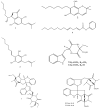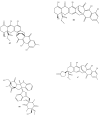Antimicrobial Action Mechanisms of Natural Compounds Isolated from Endophytic Microorganisms
- PMID: 38534706
- PMCID: PMC10967585
- DOI: 10.3390/antibiotics13030271
Antimicrobial Action Mechanisms of Natural Compounds Isolated from Endophytic Microorganisms
Abstract
Infectious diseases are a significant challenge to global healthcare, especially in the face of increasing antibiotic resistance. This urgent issue requires the continuous exploration and development of new antimicrobial drugs. In this regard, the secondary metabolites derived from endophytic microorganisms stand out as promising sources for finding antimicrobials. Endophytic microorganisms, residing within the internal tissues of plants, have demonstrated the capacity to produce diverse bioactive compounds with substantial pharmacological potential. Therefore, numerous new antimicrobial compounds have been isolated from endophytes, particularly from endophytic fungi and actinomycetes. However, only a limited number of these compounds have been subjected to comprehensive studies regarding their mechanisms of action against bacterial cells. Furthermore, the investigation of their effects on antibiotic-resistant bacteria and the identification of biosynthetic gene clusters responsible for synthesizing these secondary metabolites have been conducted for only a subset of these promising compounds. Through a comprehensive analysis of current research findings, this review describes the mechanisms of action of antimicrobial drugs and secondary metabolites isolated from endophytes, antibacterial activities of the natural compounds derived from endophytes against antibiotic-resistant bacteria, and biosynthetic gene clusters of endophytic fungi responsible for the synthesis of bioactive secondary metabolites.
Keywords: antibacterial resistance; antibiotics; biosynthetic gene clusters; endophytes; mechanisms of action; natural compounds.
Conflict of interest statement
The authors declare that they have no conflicts of interest.
Figures
















Similar articles
-
Bioactive Secondary Metabolites from Endophytic Fungi.Curr Med Chem. 2020;27(11):1836-1854. doi: 10.2174/0929867326666190916144709. Curr Med Chem. 2020. PMID: 31526342 Review.
-
Endophytic bacteria: a new source of bioactive compounds.3 Biotech. 2017 Oct;7(5):315. doi: 10.1007/s13205-017-0942-z. Epub 2017 Sep 14. 3 Biotech. 2017. PMID: 28955612 Free PMC article. Review.
-
Endophytic microbes from Nigerian ethnomedicinal plants: a potential source for bioactive secondary metabolites-a review.Bull Natl Res Cent. 2021;45(1):103. doi: 10.1186/s42269-021-00561-7. Epub 2021 Jun 8. Bull Natl Res Cent. 2021. PMID: 34121835 Free PMC article. Review.
-
Fungal Endophytes: A Potential Source of Antibacterial Compounds.J Fungi (Basel). 2022 Feb 8;8(2):164. doi: 10.3390/jof8020164. J Fungi (Basel). 2022. PMID: 35205918 Free PMC article. Review.
-
Endophytes as sources of antibiotics.Biochem Pharmacol. 2017 Jun 15;134:1-17. doi: 10.1016/j.bcp.2016.10.010. Epub 2016 Oct 27. Biochem Pharmacol. 2017. PMID: 27984002 Review.
Cited by
-
Antimicrobial, Quorum Sensing Inhibition, and Anti-Cancer Activities of Silver Nanoparticles Synthesized from Kenyan Bacterial Endophytes of Teclea nobilis.Int J Mol Sci. 2025 Apr 2;26(7):3306. doi: 10.3390/ijms26073306. Int J Mol Sci. 2025. PMID: 40244167 Free PMC article.
-
In vitro and In silico investigation deciphering novel antifungal activity of endophyte Bacillus velezensis CBMB205 against Fusarium oxysporum.Sci Rep. 2025 Jan 3;15(1):684. doi: 10.1038/s41598-024-77926-1. Sci Rep. 2025. PMID: 39753601 Free PMC article.
-
Recent Advances in Marine-Derived Compounds as Potent Antibacterial and Antifungal Agents: A Comprehensive Review.Mar Drugs. 2024 Jul 29;22(8):348. doi: 10.3390/md22080348. Mar Drugs. 2024. PMID: 39195465 Free PMC article. Review.
-
Optimizing the production and efficacy of antimicrobial bioactive compounds from Streptomyces kanamyceticus in combating multi-drug-resistant pathogens.Front Cell Infect Microbiol. 2025 Jan 6;14:1500440. doi: 10.3389/fcimb.2024.1500440. eCollection 2024. Front Cell Infect Microbiol. 2025. PMID: 39835274 Free PMC article.
-
Secondary metabolites with antimicrobial activity produced by thermophilic bacteria from a high-altitude hydrothermal system.Front Microbiol. 2024 Sep 30;15:1477458. doi: 10.3389/fmicb.2024.1477458. eCollection 2024. Front Microbiol. 2024. PMID: 39411441 Free PMC article.
References
-
- Oneill J. London: Review on Antimicrobial Resistance. Government of the United Kingdom; London, UK: 2016. Tackling Drug-Resistant Infections Globally: Final Report and Recommendations.
Publication types
LinkOut - more resources
Full Text Sources
Molecular Biology Databases

